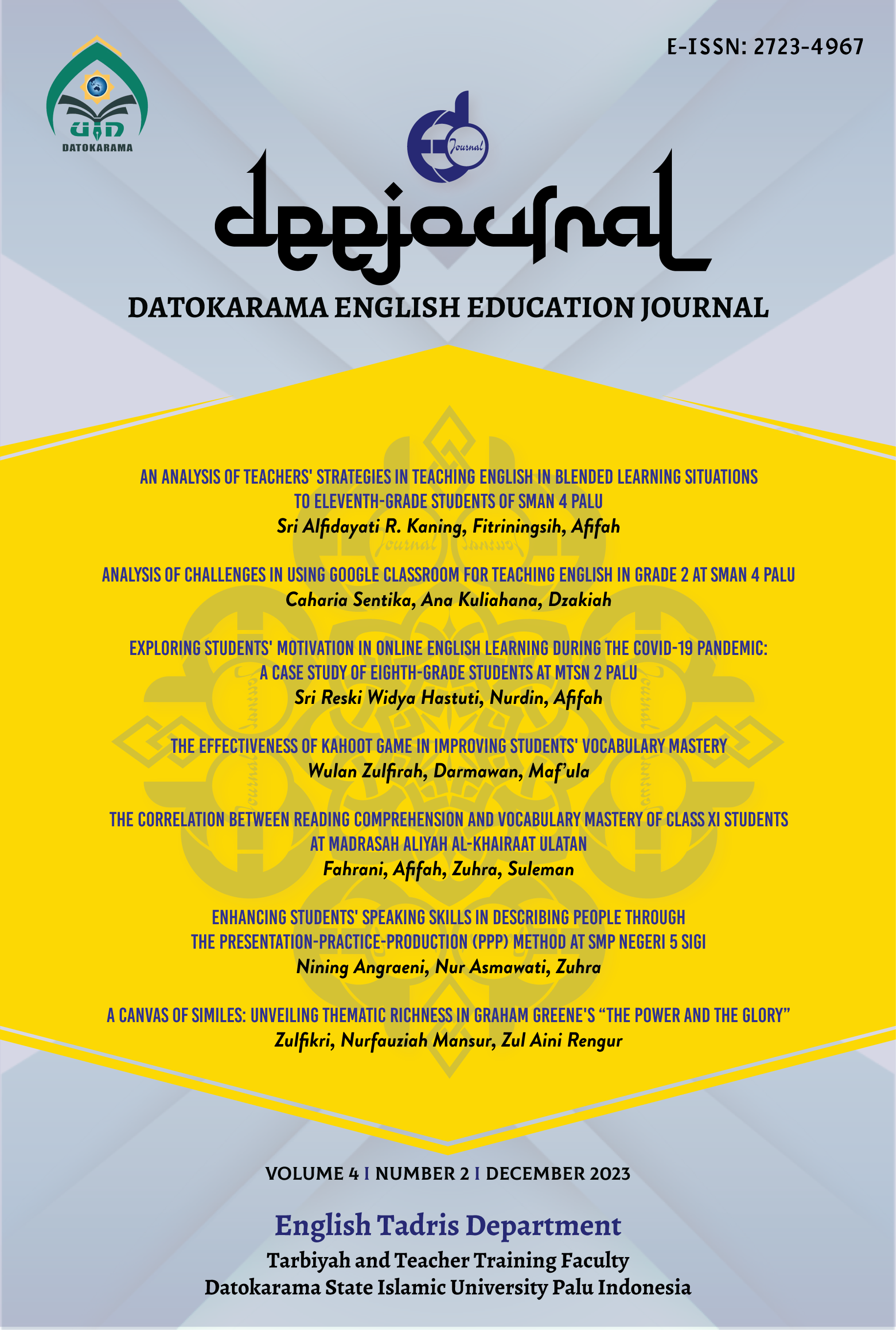A Canvas of Similes: Unveiling Thematic Richness in Graham Greene's “The Power and The Glory”
DOI:
https://doi.org/10.24239/dee.v4i2.77Keywords:
Figurative, Graham Greene, Simile, Stylistics, Thematic.Abstract
This research delves into the profound narrative artistry of Graham Greene's "The Power and The Glory" by analyzing 10 selected similes representing five types based on XuoGuo's classification. The simile types include Descriptive, Illuminative, Illustrative, Open, and Closed Similes, each contributing uniquely to the novel's thematic tapestry. Utilizing a qualitative method, the research systematically categorizes and scrutinizes similes, identifying prevalent types, and unraveling their patterns and thematic implications. Descriptive similes, comparing a shark's fin to a periscope, enhance vivid imagery and introduce concealed dangers. Illuminative similes, equating knowledge to a dark explicable spot in an X-ray photograph, provide nuanced insights into character understanding and thematic depth. Illustrative similes, likening a gold bangle to a padlock, introduce visual metaphors and layers of meaning. Open similes, like having golden shoes, infuse imaginative qualities into actions, while closed similes, comparing a man to Prometheus, draw explicit parallels, enriching characterizations with mythological undertones. This research identifies a total of 47 similes within the novel. By shedding light on the intricate use of similes in "The Power and The Glory," this research contributes significantly to understanding Greene's stylistic choices, serving as a valuable resource for scholars, literary enthusiasts, and those exploring the depths of figurative language in Greene's masterful storytelling.
References
Akram, A., et al. (2022). Exploring Simile as a Literary Device: A Comparative Study. Journal of Comparative Literature, 15(2), 45-61.
Abrams, M. H. (2015). A Glossary of Literary Terms. Cornell University. Boston, Massachusetts: Heinle & Heinle, Thomson Learning, Inc.
Azizah, N. (2019). The Analysis of Similes in Harry Potter and The Sorcerer’s Stone by J.K. Rowling. Journal of Literary Studies, 8(1), 32-45.
Borghi, A. M., et al. (2019). An Embodied View of Simile Comprehension: ERP Evidence on the Time Course of Processing. Frontiers in Psychology, 10, 1100.
Cruse, D.A. (1989). Lexical Semantics: Cambridge Textbooks in Linguistics, Cambridge: Cambridge University Press.
Crystal D. and Davy. (1979). Investigating English Style, London: Longman Group Limited.
Firuza, A. (2020). Semantics and Semiotics: Understanding Meaning. International Journal of Linguistics, Literature and Culture, 6(2), 12-21.
Gafiatulina, G. R. (2004). Figurative Language in Modern English: A Semantic and Stylistic Analysis. Peter Lang.
Galperin, I.R. (1977). Stylistics, Moscow: Vishaja Skola.
Israel, A., et al. (2004). Metaphor and Simile. The Handbook of Pragmatics, 67-84.
Long, M. H. (2019). Semantics. In The Routledge Handbook of Semantics (pp. 1-16). Routledge.
Miššíková, Gabriela. (2003). Linguistic Stylistics, Slovakia: UKF Nitra.
Myers, G. (1994). Words in Ads. Routledge. London.
Natanael, et al. (2022). An Analysis of Simile in War Room Movie. Journal of Film Studies, 17(3), 98-115.
Octha Sri Devi, Ni Putu Antary, et al. (2016). Similes In Novel Looking For Alaska By John Green. Udayana University: Jurnal Humanis, Fakultas Ilmu Budaya Ubud.
Perrine, Laurence. 2012. Sound and Sense: An Introduction to Poetry. United States of America: Harcourt Brace Javanovich, INC.
Pinkers, S. (2011). Words and rules: The ingredients of language. New York, USA: Harper Collins.
Putri, R., et al. (2022). Similes in George Bamber’s Return to Dust. Journal of Dramatic Arts, 25(1), 77-92.
Risdianoto, I., et al. (2019). Speech Act and Illocutionary Act in Daily Communication. Journal of Pragmatics Research, 1(1), 23-35.
Simatupang, T. M. (2019). Semantics: A Brief Review. Journal of Language and Literature, 10(2), 45-53.
Simpson, Paul. (2004). Stylistics: A Resource Book for The Student, New York: Routledge.
Swarniti, R. (2021). Semantics: An Insight into the Study of Meaning. International Journal of Language and Linguistics, 9(1), 15-29.
Tartakovsky, L., & Shen, J. (2019). Comparing the Processing of Open and Closed Similes: An ERP Study. Frontiers in Psychology, 10, 287.
Tulung, F. P., et al. (2021). The Analysis of Similes in Taylor Swift’s Songs. International Journal of Applied Linguistics, 4(2), 67-82.
Utami, D. N., et al. (2021). Figurative Language in Literary Works: An Overview. Journal of Literary Studies, 11(2), 101-116.
XiuGuo, Z. (2005). Similes in English: A Cognitive Approach. Foreign Language Teaching and Research Press.
Znamenskaya, I. A. (2004). Stylistics of the English Language. Moscow State University Press.
Downloads
Published
How to Cite
Issue
Section
License
Copyright (c) 2023 Zulfikri, Nurfauziah Mansur, Zul Aini Rengur

This work is licensed under a Creative Commons Attribution-NonCommercial 4.0 International License.


















